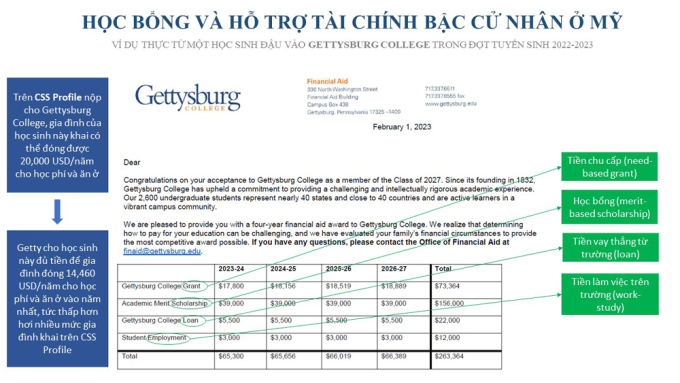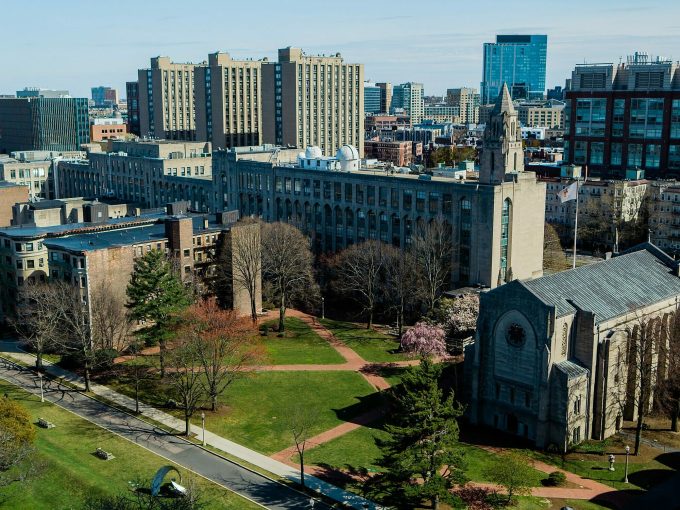If qualified to enter a university in the US, candidates may be considered for scholarships or financial aid with many types of grants, loans, etc., depending on their academic performance and family finances.
Mr. Nguyen Ngoc Khuong, a strategic consultant and independent consultant in Minnesota, USA, guides on distinguishing between types of scholarships and financial aid in American universities:
Scholarship and financial aid policies at American universities are quite complicated. Some schools only award scholarships based on academic merit (Merit-based Scholarship) or support based on family financial ability (Need-based Financial Aid), some schools award both, and some schools offer neither.
When choosing a school, students should prioritize in this order: scholarships and financial aid, financial aid only, scholarships only, no aid.
Because of their wealth, top schools are often the most generous to international students, but they are also the hardest to get into.

Example of a scholarship and financial aid from Gettysburg College. Photo: Nguyen Ngoc Khuong
Below are the forms of scholarships and financial aid at American universities:
Merit-based Scholarships: Many parents and students often ask about scholarships, not realizing that they are just one element of a financial aid package. Merit-based scholarships, often called Presidential Scholarships, Excellence Scholarships, or Trustee Scholarships, range in value from $5,000 to full or full tuition.
You can get two or three scholarships and combine them, but some schools don’t allow this. Schools rarely publish criteria, just write that they will be awarded to the best applicants. Many schools don’t publish the list or the value of the scholarships.
Financial Aid (Need-based Financial Aid ): After you have been awarded a certain amount of scholarships, the school will start considering financial aid. This is based on the financial ability of the student's family. Families with lower ability to pay are given more money than families with higher ability to pay.
For example, you apply to a school with a total cost of 60,000 USD/year (more than 1.4 billion VND) but declare that you can only pay 20,000 USD. After reviewing your application, the school sees that you are a good student and grants you a scholarship worth 30,000 USD/year. The remaining payment is still beyond your ability, so the school considers adding another 10,000 USD so that your family receives 40,000 USD and just enough money to pay.
Financial aid comes in three forms: grants, work-study, and loans.
Grants: These are grants based on a student’s ability to pay, regardless of academic performance. Students will receive as much support as they need. For American students, they receive grants from three sources: the federal government (Federal grant), the state government (State grant), and the school (Institutional grant).
Meanwhile, international students only receive a stipend from the school. The value of the stipend is flexible and can change every year based on many factors. For example, the third year you move out, the stipend will decrease because the school thinks it is cheaper to live off campus than on campus, so you do not need as much money as before.
Work-study: Based on financial need, you may be allowed to work on campus, with limits. For example, I was previously allowed to make up to $4,500 a year. I know people who make up to $5,000 a year, but I’ve never met anyone who makes more than that, because you’re only paid about $10 an hour and are legally limited to working 20 hours a week.
The usual part-time jobs at school are working in the library, standing guard at the gallery, or getting up early to mow the lawn. The desk jobs are the best because you can study, but they are often taken by seniors. So the freshmen have to do the harder work like washing dishes.
Loans: Also based on financial needs, candidates can borrow money from many different sources. American students can borrow money from the federal government (Federal loan), from the school, or from the bank. International students can borrow money directly from the school and from the bank.
To find out if a school offers financial aid, type the school name and add "international students application" in Google to your list of requirements. If so, the school will usually require a financial aid application (CSS or ISFAA).

Boston University campus. Photo : Boston University
Some examples:
You apply to the University of Richmond, which has a total cost of $78,000 a year, while your family can only afford $20,000. The school offers both scholarships and financial aid for international students. If you apply for the full Richmond Scholars scholarship, the admissions committee will first consider your academic performance.
Note that full scholarships usually require a separate application in addition to the standard application. If you are not awarded a full tuition scholarship, the school will consider you for a full tuition scholarship, also based on academic performance. If you are awarded a full tuition scholarship, you will only have to pay for room and board.
If you fail, the financial aid office will create a four-part package: scholarships, grants, work-study, and loans. Since you can only pay $20,000 a year, you need $58,000 from the school to be able to attend.
In its financial aid package, Richmond will award you two merit-based scholarships, worth $25,000 and $15,000. The school will also provide an $8,000 grant, a $5,000 work-study grant, and a $5,000 loan. That adds up to $58,000, just enough to get you into school.
If you’re applying to Boston University: This school only awards merit-based scholarships, so it doesn’t require applicants to fill out a financial aid application. First, they consider the full-tuition Trustee Scholarship based on academic merit. If you’re accepted, you’ll only have to pay more than $18,100 a year for room and board. If not, they consider the Presidential Scholarship, also based on academic merit, for $25,000.
With a total cost of more than $83,200/year, if you get a scholarship, you will pay about $58,000 more. If not, the family will have to pay the entire amount.
Nguyen Ngoc Khuong
Source link



































































































Comment (0)